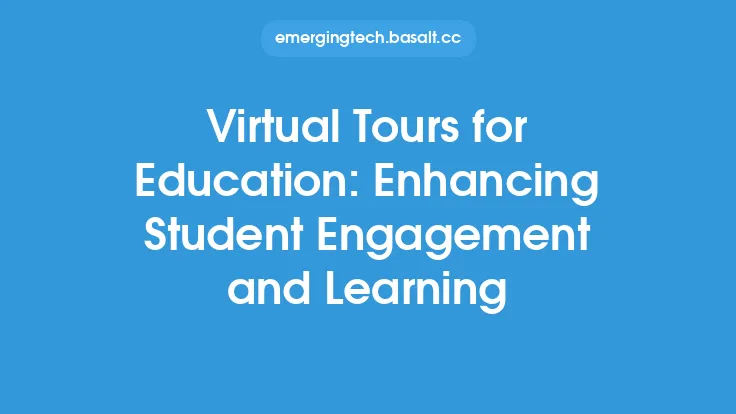The use of technology in education has been on the rise in recent years, and one of the most exciting developments in this field is the integration of augmented reality (AR) into the learning experience. AR has the potential to revolutionize the way we learn by providing interactive, immersive, and engaging experiences that can enhance student understanding and retention. In this article, we will explore the concept of AR in education, its benefits, and how it can be used to enhance the learning experience.
Introduction to Augmented Reality in Education
Augmented reality is a technology that overlays digital information onto the real world, using a device's camera and display to blend the physical and virtual environments. In education, AR can be used to create interactive and immersive learning experiences that can help students to better understand complex concepts and ideas. AR can be used in a variety of subjects, including science, technology, engineering, and mathematics (STEM), as well as in language learning, history, and other humanities subjects.
Benefits of Augmented Reality in Education
The use of AR in education has a number of benefits, including increased student engagement and motivation, improved understanding and retention of complex concepts, and enhanced collaboration and communication among students. AR can also provide personalized learning experiences, allowing students to learn at their own pace and in their own way. Additionally, AR can help to make learning more fun and enjoyable, which can lead to increased student satisfaction and reduced dropout rates.
Technical Requirements for Augmented Reality in Education
To implement AR in education, a number of technical requirements must be met. These include the need for devices with cameras and displays, such as smartphones or tablets, as well as software and content that is specifically designed for AR. The software and content must be able to track the device's movement and orientation, and to overlay digital information onto the real world in a way that is seamless and intuitive. Additionally, the technical infrastructure of the educational institution, including the network and internet connectivity, must be able to support the use of AR.
Applications of Augmented Reality in Education
AR can be used in a variety of educational settings, including classrooms, laboratories, and online learning environments. Some examples of AR applications in education include virtual labs, where students can conduct experiments and investigations in a virtual environment, virtual field trips, where students can explore places and environments that may be difficult or impossible to visit in person, and interactive simulations, where students can model and analyze complex systems and phenomena. AR can also be used to create interactive and immersive learning experiences, such as games, puzzles, and quizzes, that can help to engage and motivate students.
Examples of Augmented Reality in Education
There are many examples of AR being used in education, including the use of AR to teach anatomy and physiology, where students can use AR to visualize and explore the human body in 3D. AR is also being used to teach languages, where students can use AR to practice their language skills in a virtual environment. Additionally, AR is being used to teach history, where students can use AR to explore and interact with historical artifacts and environments. Other examples of AR in education include the use of AR to teach mathematics, science, and engineering, where students can use AR to visualize and interact with complex concepts and systems.
Challenges and Limitations of Augmented Reality in Education
While AR has the potential to revolutionize the learning experience, there are also a number of challenges and limitations that must be considered. These include the need for significant investment in hardware and software, as well as the need for training and support for teachers and students. Additionally, there are concerns about the potential for AR to be a distraction, rather than a tool for learning, and about the potential for AR to exacerbate existing inequalities in education. Furthermore, there are also technical challenges, such as the need for high-quality internet connectivity and the need for devices that are capable of supporting AR experiences.
Future of Augmented Reality in Education
Despite the challenges and limitations, the future of AR in education is exciting and promising. As the technology continues to evolve and improve, we can expect to see more widespread adoption of AR in educational settings. This may include the development of new AR platforms and tools, as well as the creation of new AR content and experiences that are specifically designed for education. Additionally, we can expect to see more research on the effectiveness of AR in education, which will help to inform the development of AR-based learning experiences and to ensure that they are effective and engaging for students.
Best Practices for Implementing Augmented Reality in Education
To get the most out of AR in education, it is essential to follow best practices for implementation. These include starting small and scaling up, as well as providing training and support for teachers and students. Additionally, it is essential to ensure that AR experiences are aligned with learning objectives and outcomes, and that they are designed to be interactive and engaging. Furthermore, it is essential to continuously evaluate and assess the effectiveness of AR experiences, and to make adjustments and improvements as needed. By following these best practices, educators can help to ensure that AR is used in a way that is effective, engaging, and supportive of student learning.





